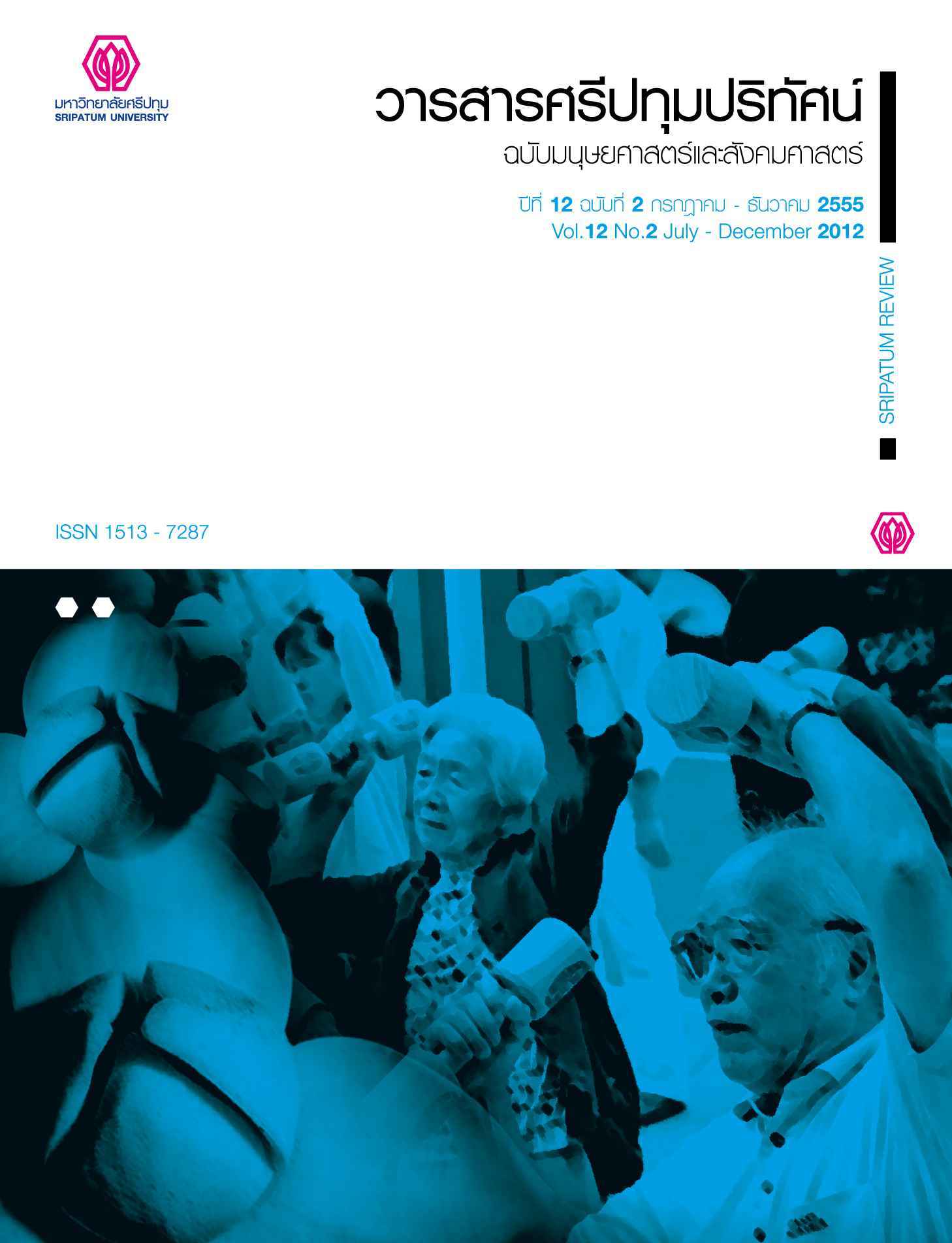MODELS OF TOURISM ACTIVITIES APPROPRIATE FOR THE CAPABILITY AND CONTEXT OF THE COMMUNITY FOR DEVELOPMENT OF COMMUNITY – BASE TOURISM BUSINESS SAN KHAMPAENG DISTRICT, CHIANG MAI PROVINCE
Main Article Content
Abstract
The research project is a qualitative research based on participatory action research process (PAR) carried out in 3 sub-districts of Sankampang District, i.e. Orn Tai, Buag Kang and Rong Wua Dang. The target group includes 6 groups of the people who volunteer to run the community-based tourism business in Sankampang District, with 10 persons selected from each group making the total of 60 as a sampling group. The research tools include not only the official and non-official interviews but also the data collection from focus group discussion so that the information can be gathered regarding the community capital and tourism elements. The study results of the examination and validation of the 5 aspects of community capitals and the study of the 5 aspects of tourism elements in 3 sub-districts show that the tourism activities can be appropriately set according to each community potential and context with the following varieties : 1) For Rong Wua Dang Sub-district, it should be Paa Dong Pong Wai eco-tourism type, managed by Baan Muang Kiew tourism organization group, Moo 4, Rong Wua Dang Sub-district 2) For Buag Kang Sub-district, it will be Yong cultural tourism type arranged by Buag Kang Yong tourism organization group, Moo 1, 2, 3 and 4, Buag Kang Sub-district 3) For Orn Tai Sub-district, it will be Baan Pong Huay Larn cultural and eco- tourism types, managed by Baan Pong tourism organization group, Moo 8, Orn Tai Sub-district.
Article Details
1. กองบรรณาธิการสงวนสิทธิ์ในการพิจารณาและตัดสินการตีพิมพ์บทความในวารสาร
2. บทความทุกเรื่องจะได้รับการตรวจสอบทางวิชาการโดยผู้ทรงคุณวุฒิ แต่ข้อความและเนื้อหาในบทความที่ตีพิมพ์เป็นความรับผิดชอบของผู้เขียนแต่เพียงผู้เดียว มิใช่ความคิดเห็นและความรับผิดชอบของมหาวิทยาลัยศรีปทุม
3. การคัดลอกอ้างอิงต้องดำเนินการตามการปฏิบัติในหมู่นักวิชาการโดยทั่วไป และสอดคล้องกับกฎหมายที่เกี่ยวข้อง
References
ไกรสิทธิ์ สิทธิโชดก และคณะ. 2546, “การเสริมสร้างศักยภาพการท่องเที่ยวเชิงวัฒนธรรมอาข่า” ใน การท่องเที่ยวโดยชุมชน: แนวคิดและประสบการณ์พื้นที่ภาคเหนือ, สินธุ์ โรบล (บรรณาธิการ), สำนักงานกองทุนสนับสนุนการวิจัย, เชียงใหม่ หน้า 103-109.
ดารณี บุญธรรม และคณะ. 2546, “การจัดการการท่องเที่ยวเชิงนิเวศและวัฒนธรรมโดยชุมชนชาวม้ง บ้านน้ำคะ-สานก๋วย ตำบลช้างน้อย อำเภอปง จังหวัดพะเยา” ใน การท่องเที่ยวโดยชุมชน: แนวคิดและประสบการณ์พื้นที่ภาคเหนือ, สินธุ์ สโรบล (บรรณาธิการ), สำนักงานกองทุนสนับสนุนการวิจัย, เชียงใหม่ หน้า 110 - 115.
เทศบาลนครเชียงใหม่.(2554).จำนวนนักท่องเที่ยว.[ออนไลด์].ค้นวันที่ : 12 กันยายน 2554.
เทิดชาย ช่วยบำรุง. 2552, บทบาทขององค์กรปกครองส่วนท้องถิ่นกับการพัฒนาการท่องเที่ยวอย่างยั่งยืนบนฐานแนวคิดเศรษฐกิจพอเพียง. สำนักพิมพ์คณะรัฐมนตรีและราชกิจจานุเบกษา, กรุงเทพฯ.
นำชัย ทนุผล. 2545, มกราคม - มีนาคม. การพัฒนาธุรกิจการท่องเที่ยวเชิงนิเวศในชุมชนบ้านโปง อำเภอสันทราย จังหวัดเชียงใหม่. จุลสารการท่องเที่ยว. 21(1), 44 – 55.
มิ่งสรรพ์ ขาวสะอาด และคณะ. 2548, การพัฒนาการท่องเที่ยวเชิงบูรณาการที่ยั่งยืนในลุ่มแม่น้ำโขง. สถาบันวิจัยสังคม มหาวิทยาลัยเชียงใหม่, เชียงใหม่.
สายรุ้ง ดินโคกสูง. 2549, การจัดการท่องเที่ยวโดยชุมชน: กรณีศึกษาหาดชบา ตำบลชบา อำเภอเมือง จังหวัดอุบลราชธานี, วิทยานิพนธ์ปริญญาบริหารธุรกิจมหาบัณฑิต มหาวิทยาลัยขอนแก่น.
สำนักพัฒนาทุนและองค์กรการเงินชุมชน กรมการพัฒนาชุมชน. 2553, ค้นวันที่ :12 กันยาย 2554.
Lesego S. Sebele. 2009, “Community-based tourism ventures, benefit and challenges: Khama Rhino Sanctuary Trust, Central District, Botswana”, Tourism Management (Accepted 15 January 2009).
Libanda B. And Blignaut J.N.. 2008, “Tourism’s local benefits for Namibia’s community based natural resource management areas” International Journal of Ecological Economics and Statistics. Vol. 10 No. W08, pp. 40-52.


